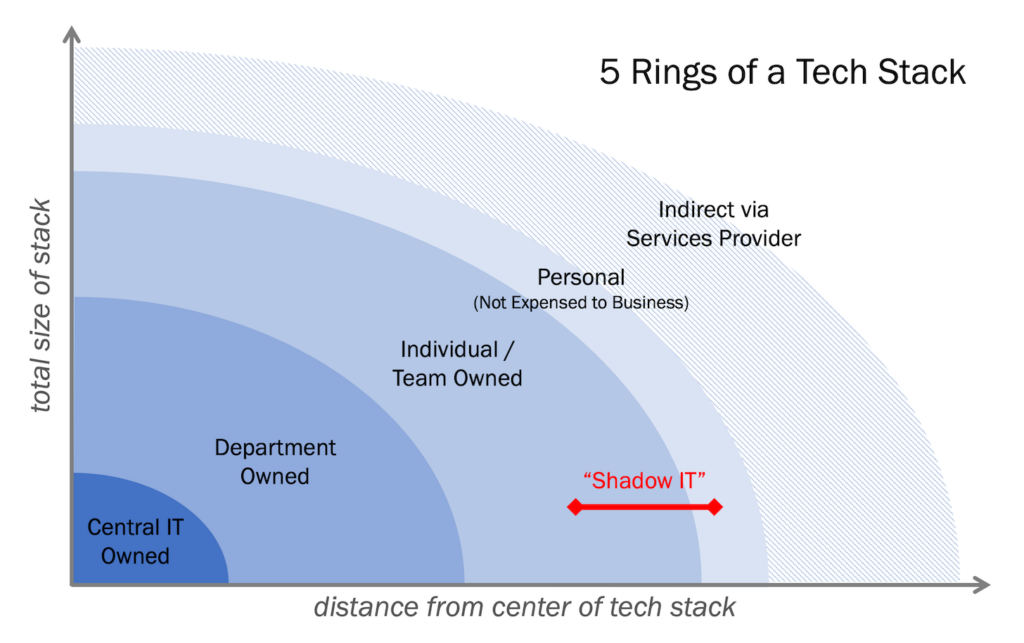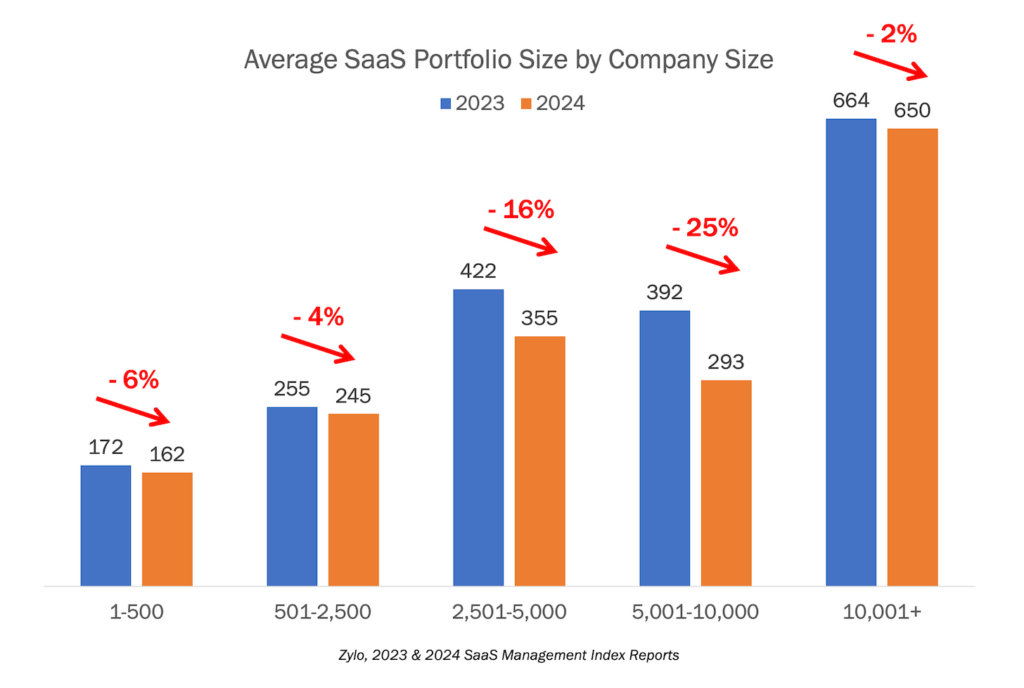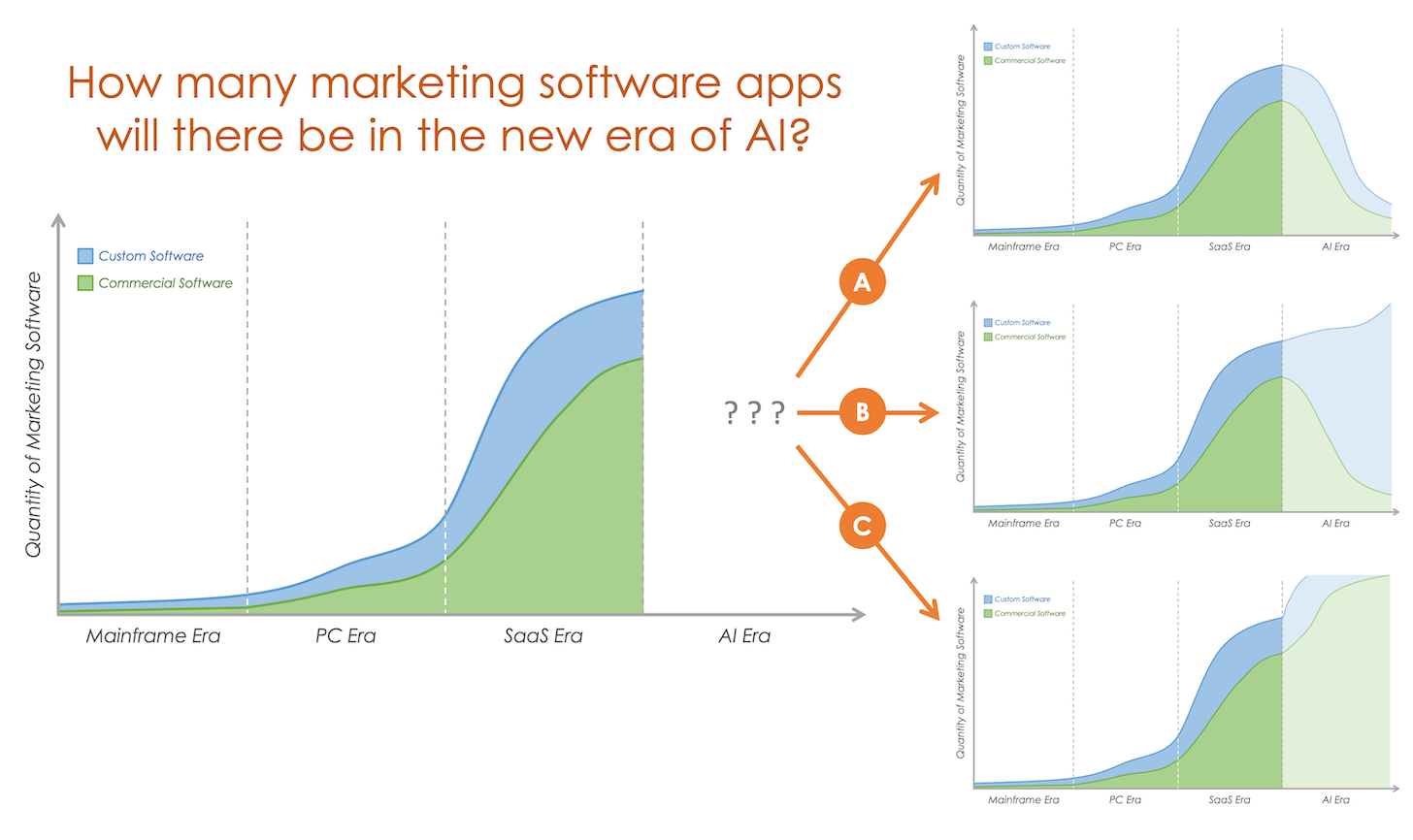
For years, people have been prognosticating the collapse of the martech landscape. That all these thousands of different martech apps are going to be winnowed down to a handful of winners. For the past 12 years, those predictions have been consistently proven wrong, year after year after year. (The myths of martech are nothing if not resilient.)
But maybe, just maybe, the Age of AI will be the inflection point that will bring those failed prophets redemption.
We’re going to give them — and you — a chance to place a bet on three scenarios for the future of marketing software in the AI Era that’s rapidly unfolding around us.
But first I’d like to offer a simple explanation for why predictions of martech’s collapse have been so wrong for the past decade. In a nutshell: people expected the market dynamics of the SaaS Era to play out like they had in the PC Era that came before it.
But software in the SaaS Era was radically different. Development, distribution, economics, interface, integration, buying, selling, context, experience — pretty much everything about software underwent massive structural shifts. Comparing software businesses from the PC Era to those of the SaaS Era was apples and oranges. Heck, it was more like apples and orangutans.
The SaaS Era software market wasn’t a “broken” version of the PC Era that was destined to eventually self-correct. It was a fundamentally different creature that was correct in different ways. And we only really learned the nature of it as it played out over a couple decades.
It seems likely that the AI Era could be as different from the SaaS Era as SaaS was from the PC and mainframe eras that came before it.
So what will the future of software — let’s narrow it to marketing software — look like? I’ve sketched out three possibilities and will walk through the rationale for each. To be sure, the future might look like something else entirely. Or some variation of or blend between these models. But in broad strokes, these seem like the major alternatives.
Option A: Software collapses into a few super apps

Okay, martech doom-sayers, this is the scenario you’ve been pining for. It’s possible that AI enables a small number of big vendors to embed HUGE amounts of functionality into their products while simultaneously simplifying the user interface to all that power with genie-like AI co-pilots that make it manageable by mere mortal marketers.
Who will those winning vendors be? Probably the largest incumbents today who already have market share and significant resources to quickly spend their way into AI-powered dominance. Those who have a ton of data in their flywheel are also going to be significantly advantaged.
What’s interesting is we might see major companies from outside today’s martech space move in with the benefit of their AI prowess and cross-business/cross-consumer scale. Amazon, Google, Meta, and Microsoft could all be formidable contenders in this scenario.
In this scenario, where a few super apps do it all, I don’t think you’d need a lot of custom-built software either.
While this martech superapp theory is conceivable, it strikes me as just steps away from the singularity. If a single app can manage everything in marketing — which any CMO will attest is one of the most complex, diverse, and ever-shifting fields in business — then why can’t it run the whole business? If it can do that, why not run the world?
Option B: AI lets everyone build most martech custom
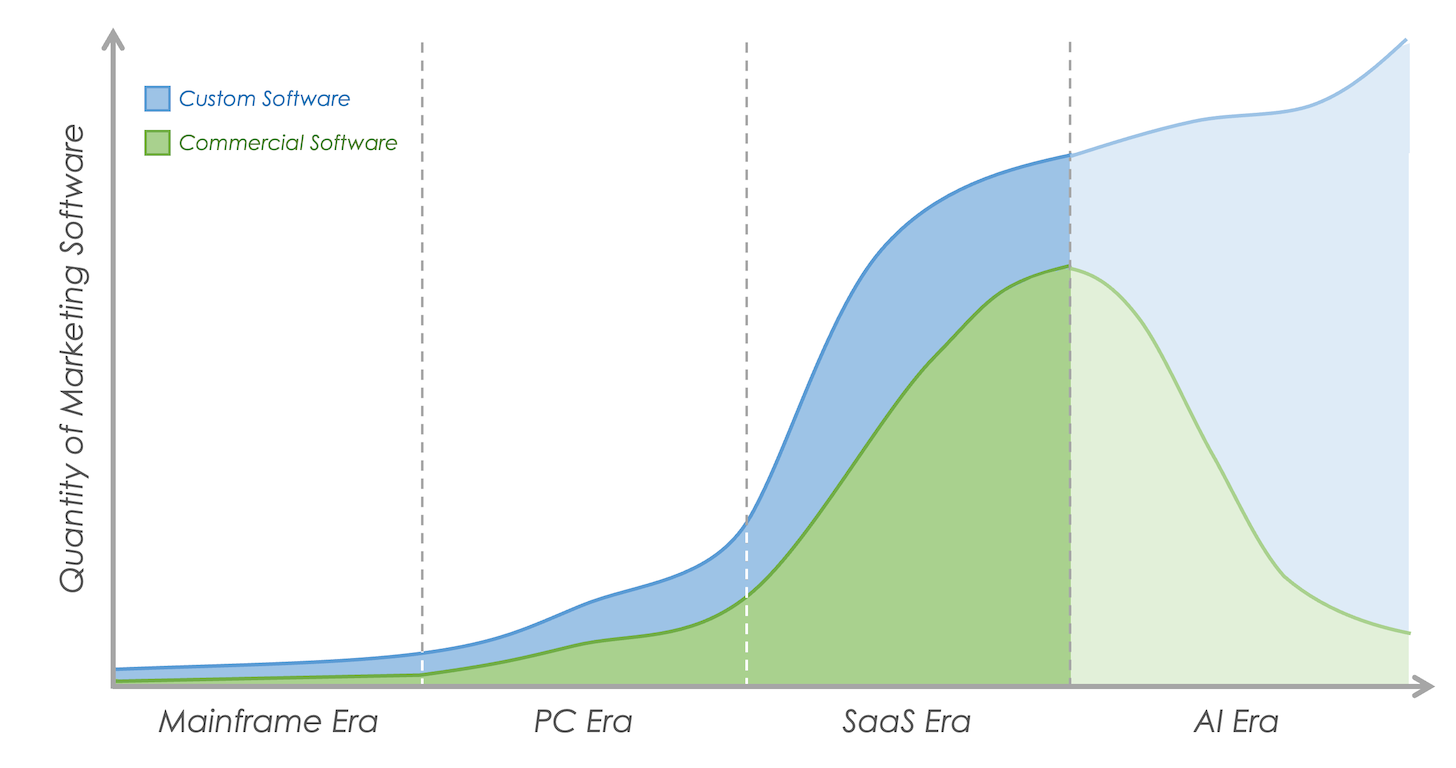
Option B doesn’t converge to one-app-to-rule-them-all. Quite the opposite. It delivers much greater specialization of software, in a world where AI enables many more people to build much more custom software, faster and better.
For software engineers, this will be with coding co-pilots and more advanced, AI-powered services just an API call away.
But the real explosion of custom software will come from the next generation of AI-infused low-code/no-code platforms. No-code martech was already on the path to giving marketing operations pros and power-user marketers superpowers to craft workflows, integrations, interactive content, data analyses, simple web apps and mobile apps, and more. AI will both boost the power of these no-code tools and make them more accessible to general business users. It could easily 100X the amount of custom software “apps” in the world.
At this intersection of no-code AI and composability, most marketing teams will be able to assemble custom software that is tailored to their specific needs and business operations. It will be highly malleable and mark the demise of Inverse Conway’s Law (my observation that companies have had to adapt their businesses to the software they use rather than the other way around).
There’s still a place in this scenario for commercial software. But it will be mostly no-code tools for building things, API services these no-code apps draw upon, and the underlying platforms that provide critical cohesion across all these purpose-built agents, apps, and automations.
The vast majority of apps marketers work with day-to-day will be built, not bought.
Option C: An exponential explosion of all software
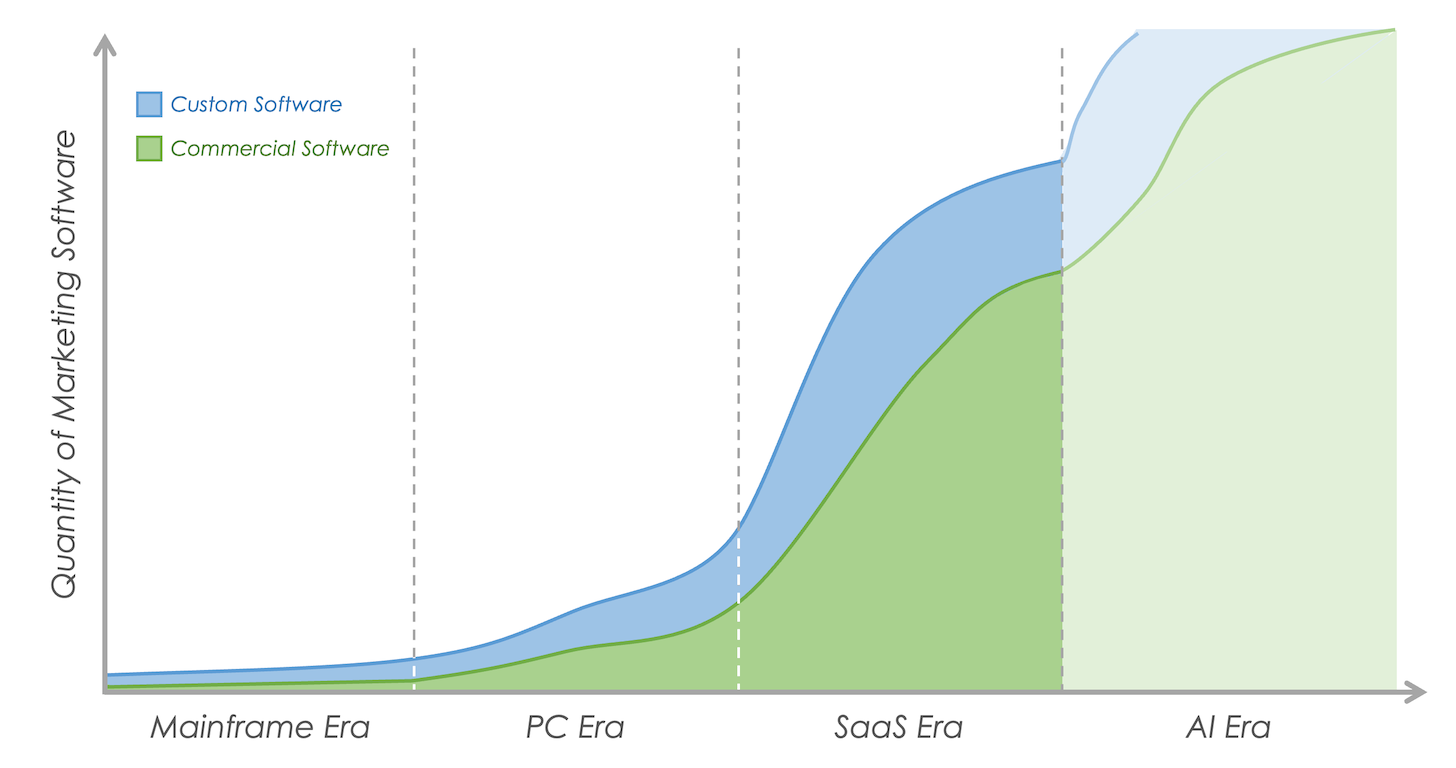
Option C looks at the size of today’s commercial martech landscape and says, “Hold my beer.” Like Option B, this scenario will see an exponential explosion of new specialized software apps. But in this case, a large number of them are commercially available apps that marketers buy, not build.
If you took a snapshot of the emerging AI Era today, this would be the scenario currently playing out. A flood of new AI-powered apps rolls out every week these days.
But will that last? There’s certainly a limit to how many large software companies the market can hold. But it’s possible that the long-tail of many smaller software companies could grow significantly. They won’t fit the VC funding model that defined much of the martech wave of the 2010’s. But they could be bootstrapped and profitable small businesses.
This is what Kevin Xu, senior director at GitHub, envisions in a post he wrote explaining how AI will create more developers, not less:
“More digital products will be created, but the companies that build them will on average be smaller. More of them will be bootstrapped, self-funded, generating revenue earlier in their lifecycle, and not funded by VCs. There will be more and more one-person teams building meaningful products and companies.”
Of course, there will still be large software companies at the head of the tail. In particular, platforms that serve as a cohesive force for these myriad of specialized apps will be immensely valuable. This is why I believe the biggest strategic battles today are around winning ecosystems. (Of course, I’m biased, since I work at HubSpot on their platform ecosystem.)
There’s composability here, like in Option B. But many more of the “Lego blocks” you’re composing with are bought, not built.
This explosion of commercial apps, mini-apps, and micro-apps doesn’t preclude the possibility of a ton more custom software too. In my illustration above, the blue area of custom apps stretches beyond the boundary of the graph. By how much? I’ll leave that to you as an exercise for the reader.
What’s your prediction for the future of martech?
So which do you think is most likely? Scenario A, B, or C? Why?
Don’t worry, I won’t hold you to your prediction. Because in truth, I think all three of these scenarios are plausible. Part of why I’ve sketched this is to help people keep an open mind about these different alternatives, so we can be ready to adapt to any of them.
Because almost certainly, the AI Era will be different from the SaaS Era.
P.S. My best guess? I’ll go with Option C. But Option B is a close second.
